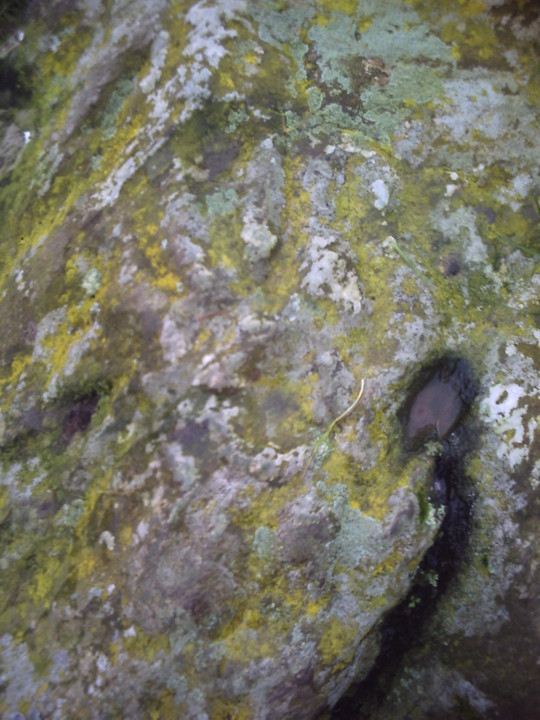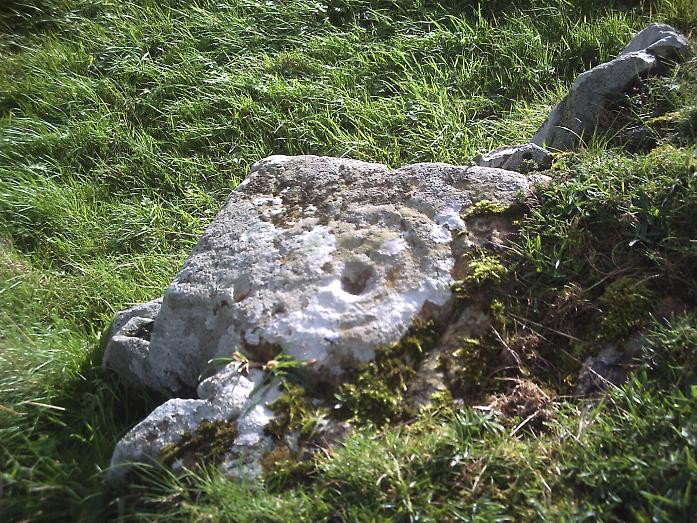
More of the motifs on the lower part of Panel A.

More of the motifs on the lower part of Panel A.

The deeply incised motif at the base of Panel A,

The carvings at the top left of Panel A. The (17/7/12) newly discovered motif is centre left of the picture. The large “keyhole” motif may well be the longest bit of sculpturing at Stronach Wood – the pecking comes out rather well in this pic. I have added a 2 litre Scottish Fizzy drink bottle for scaling purposes.

A view across the top of Panel A. The little fellow centre left is last night’s newbie....

The most recent (17/7/12) discovery at Stronach Wood – an additional motif for Panel A (like Panel A actually needed any more...). Lovely!

Sannox 2 – a sunny green isle in the dark deep of the forest on Leac Gharbh.

One of the exposed chambers in Sannox 2. There are no less than seven of these chambered cairns recently been identified scatteredacross the forestry plantation on the slopes of Leac Gharbh overlooking the mouth of the North Sannox Burn.
It was my OH who picked this summer’s Arran holiday cottage deep in the heart of the Merkland Wood. My preliminary researches confirmed my suspicions – the cist I had unsuccessfully sought in previous years lay somewhere within the cottage’s grounds. Last July I had spent a frustrating couple of hours getting eaten alive by midges and cut and scratched by bracken and rhododendron as I tried to find the cist said by the antiquarians to be “situated on a small eminence” above a burn and described by the OS to be “poorly preserved”.
I parked in the small tarmacked boat ramp and crossed the road to the trackway leading up to 2 cottages at Maol Don. Do not go up this track, instead enter the rhododendron jungle to the left of the cottage track but to the right of the roadside stone wall.
I found a vestigal path which sort of becomes a burn. To the left rises the “small eminence”. This “small eminence” turns out to be a thirty foot cliff whose top is swathed in head-high bracken and rampant rhododendron. As I clambered up the steep crumbling bank I found myself gazing into a dark hole surrounded by mossy stones. I knew I was right on the money. Badger activity six feet below this cist has left it in a bit of a precarious position. This cist is not poorly preserved – indeed it is in great nick – and sits jutting out of the sloping bank above the burn just just below the flat top of the “eminence”. In previous attempts to find this cist I’d been stumbling around on the eminence’s “summit top” among the tick-laden, midge-ridden ferns and shrubs.The landowner’s attempts to hack back the invasive rhododendron has left many ankle breakers and stumps which are real trip hazards in the deep undergrowth. But you don’t need to go there & if you find yourself up there amongst the bracken you have passed the cist.
The cist is complete, the mossed-over capstone is in place, the four side slabs sit vertical and in position. This cist’s dimensions are a bit larger than those described on Canmore, so a part of me wonders if this is the same cist. There are no photographs or sketches of the Merkland cist described on Canmore (or in Balfour’s Book of Arran Vol 1)) to work from, but I am presuming it has to be the same one. This is a very quiet, deep woodland setting for a cist in a fine state of preservation. I stood brushing off midges with the slanting bars of evening sun transforming the wood into a tropical rainforest of rhododendron blooms, green ferns and deep moss with tall natural Scots Pines forming a scented canopy. I got the impression that no-one had visited in a very long time. A very cool resting place.

The Blatch Cave Grotto (Chamber Four) after some cavers had been for a visit in 1963.

Photo of the Blatch Cave Grotto (chamber 4 in Wookey Hole Cave) in 1958.
After a Sea-Trout commando expedition myself and Sam Spade dropped in on Gatehouse of Fleet en route home. We parked outside the house which posed as “The Green Man” pub in The Wicker Man and strolled out through the town to the Borland Hills. Some very perky stirks just out into pasture from the long delayed Spring meant an abrupt retreat from the area of Rutherford’s Witnesses before we could locate the Rock Feature.
Time was pressing upon us to return home but we figured we had half an hour left so I suggested we have a wee search for some of the Lagganmullan panels. We drove quickly out towards Skyreburn and parked at a little pull in on the Glenquickan Road. The fields were full of Ewes and lambs and our presence soon had literally hundreds of the things scuttling away through the connecting field gates, baaahing and bleating as they rushed up towards the farthest field at Lagganmullan Wood.
The field I wanted to check out for rock art was mercifully free of livestock (I am continually beset by livestock issues on my stone forays) and after wandering hoplessly up to the top field wall, I could see no slabs or rocks protruding from the surface of the smooth turf. In desperation I grabbed a handful of turf and tried to peel it back – it came away and revealed a beautiful pair of cups and rings. Sam Spade nearly fell over in surprise and amazement. I was pretty gobsmacked to have fluked it in such a random way too! We found another part of the panel by peeling some more easy turf back. A good soaking with some water & some photos before replacing the turf then we headed up to the top field where I wanted to check out a group of stones on a small hillock which had caught my eye on visits to the area last Autumn and at Easter this year. See if you can spot them here (a few of the blobs are trees).
The Ewes and lambs which had fled from us when we entered the first field were now crowded around the stones on the hillock. I didn’t want to further disturb the livestock and incur the wrath of the farmer who was now approaching on his quad, so we just photographed them from a few hundred yards away. From the air, the stones form a rough triangle. Field clearance? Modern/ Victorian Folly? Messed up ancient site? Who knows... its not on Canmore and I’ll have to wait for another few weeks till I’m back in the area to get a proper look at the arrangement. Failing that... I’m back down for another week at Borland in October.... The lambs will have gone off to market and the Ewes will be off the hills by then...

The large stone setting near Lagganmullan 8, 9 and 10. Not sure if it is field clearance or a modern folly.

One cup and ring at Lagganmullan 8 on 3 June 2012.

The motifs nearest the field dyke 3 June 2012.

Two outer panels of Lagganmullan 8 on a sunny Galloway afternoon 3 June 2012.
May 2012 dig at Trusty’s Hillfort.

Pre-Bothy Band album from 1974. Newgrange Spiral on whisky bottles, album sleeves etc. I saw the triple spiral on a rug in a hotel in Letterkenny years ago but I didn’t get a photo.

Sunset on Friday 13 April 2012 looking across the circle to the masts on Cambret Hill. I love the intrusive stamp of our ancient forebears on the 20th Century telecommunications equipment. It’s quite in the spirit of “The Changes” or “Children of the Stones”. A lovely place. I set up half a dozen Red Deer as I turned past the dyke to visit the cist across the burn.

The fine stonework which makes up Glenquicken and Cambret’s dykes may be a clue as to where all the cairn material went...

Looking West over the cist towards Knockeans Hill. Sunset on Friday 13th April 2012.

The Ewe Hill Hillfort at the North end of Bizzyberry Hill. Looking to the East.

Nice to have this in your garden eh? What a rockery!

Print from 1838 by Alex Arthur of the Kirkton Manor Stone in its original position. Courtesy of British Heart Foundation Shoppe in Peebles today. It was marked at £1 but I put an extra 50p into the box for good measure.

The main cup and ring is centre picture.

I took this photo blurry on purpose. It helps ease out the detail of all the lichen and weathering and gives more of an idea of the general shapes which this deeply carved motif throws out at you.

The weathered and lichened Barharrow 8. A major cup with one ring has at least seven deep (yellow lichened) runnels running out from it reaching towards another cup.
Although much weathered, these carvings are still fairly deep and their 3D appearance hints at tantalising shapes and interpretations.

The weathered and lichened Barharrow 8. A major cup with one ring has at least seven deep (yellow lichened) runnels running out from it reaching towards another cup.
Although much weathered, these carvings are still deep and their very 3D appearance hints at tantalising shapes and interpretations.

“New” rock art panel (Barharrow 9 ?). Two big cups with major runnels with triangle motif on either side. Top right is a dice like pattern of six cups with a prominent double grooved runnel (like a bent arm) running down to another cup.
This panel was an accidental find by myself on 20 October 2011. Rather difficult to photograph as it is under a gorse bush!

The caged Picts are on the other side of the rock outcrop from the cups.

Torrs 1 gradually mossing up and retreating back into the turf.

Torrs 2 was transformed into this delicate posy of three fine stemmed blossoms. Just add some water and sunshine.
19 October 2011.

A brief spark of sunshine between dark skies gave us a huge double rainbow hanging high as we drove out of Borgue. When we got to the rock art I managed to get the last glimmer of one arc as it faded...

Some flukey, bright sunshine and blue, blue skies for a quick stop at Tongue Croft.

If your failing legs and ailing back simply cannot carry you out to the real High Banks, you can always view this delightful concrete effigy outside the Stewartry Museum in Kirkudbright.

The lovely lady in the Stewartry Museum in Kirkudbright was kind enough to allow me to drag the stone out from under a display case and photograph it.

Some of the walling of the ramparts still pokes through the turf.

Shot of the Western side of the rock outcrop which bears the Pictish carvings on its Eastern side. Older than the Picts, older than the original Iron Age fort. Many peck-marked cups. Some with faint rings. Some joined by runnels. Lots more under the turf.

The z-rod and double-disc on the Pictish panel at the entrance.

The smiley-faced bone pin on the Pictish panel at the entrance.

Image from Bill Drummond’s “How To Be An Artist” (Penkiln Burn book no 6) (2002). The trans-UK placard campaign was part of an ultimately unsuccessful attempt to re-sell “A Smell of Sulphur in the Wind” by Richard Long for $20,000. The essay “A Smell of Money Underground” from Drummond’s book “45” (Little, Brown and Company 2000) goes some way to explaining what eventually happened. I’ve got my piece.
Clip from a Gaelic TV programme.